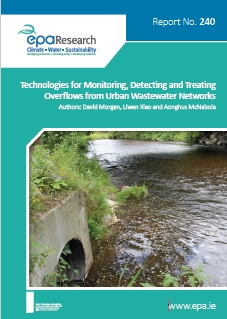Authors: David Morgan, Liwen Xiao and Aonghus McNabola
Summary: In Ireland, most urban areas are drained by combined sewer systems, which convey wastewater and stormwater in a single pipe. During rainfall the capacity of combined sewers may be exceeded, leading to untreated discharges to receiving waters via storm water overflows (SWOs), which are a source of microbial pathogens.

The project identified that compliance of SWOs in Ireland with EU and national legislation is evaluated primarily with reference to public complaints, visual inspections, and empirically-based estimations of SWO capacity. These methods are open to interpretation and difficult to implement, particularly where SWO outfall pipes are submerged or obscured. The capacity of SWOs is calculated based on population data and water consumption as a surrogate for measured sewer flows, however the project highlighted that the uncertainty inherent in this approach has not been investigated. Most EU countries have prescribed a SWO spill frequency limit in isolation or coupled with a receiving water impact assessment to demonstrate compliance.
In advance of more widespread spill monitoring of SWOs in Ireland, the project recommended that further data on SWO activations be collected under the current Annual Environmental Report, submitted by each local authority. The data should include the date of spills, preceding rainfall and catchment data such as percentage impervious and SWO pass forward flow. This will enable preliminary models to be developed to rank SWO performance on a national scale. SWO and sewer flow data should be used from several study sites to investigate the uncertainty of the current empirical SWO capacity assessment method.
The project developed a methodology to prioritise SWO monitoring using currently-available SWO assessments and mapping of sensitive receiving waters. This geographical information system (GIS) tool was tested using a dataset of 370 SWOs in Ireland, assigning approximately 24% of the sample as Priority 1, i.e. requiring immediate installation of monitoring equipment. Of the Priority 1 SWOs, 80% were located within 1 km of a protected area, as designated by EU or national legislation. The report identifies low-cost technologies for SWO spill monitoring such as temperature measurement which can be used in conjunction with traditional flow measurement methods. The review of SWO improvement options found a move towards green infrastructure to reduce stormwater flows to combined sewers, as an alternative to the provision of sewer network storage, due to its multiple environmental benefits and increased resilience to climate change.
https://www.epa.ie/media/epa-2020/publications/research/Research_240_Thumbnail[1].jpg